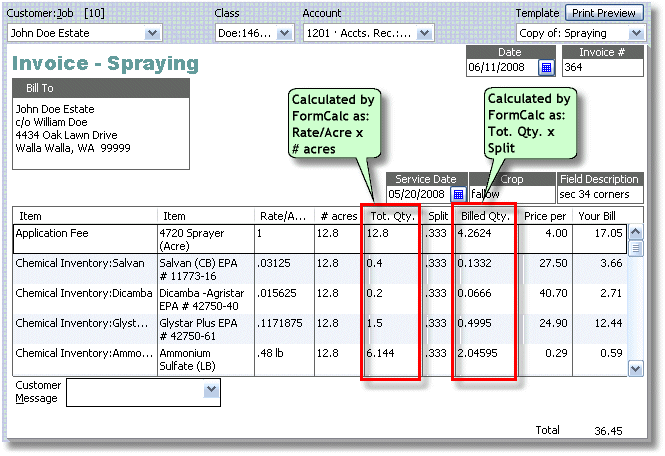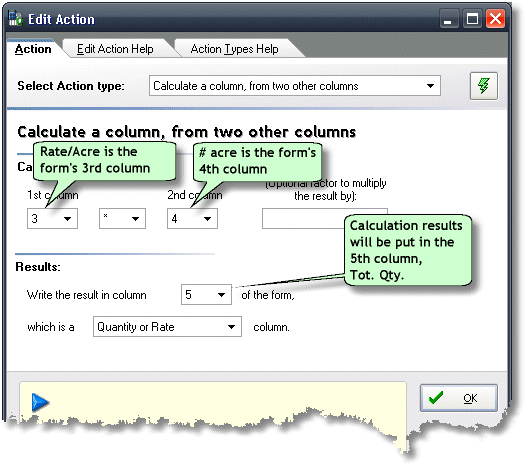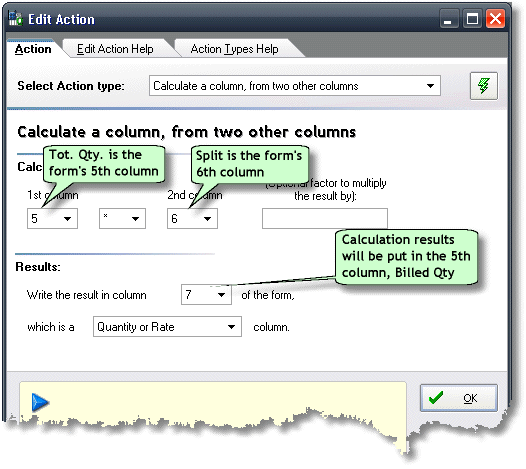This example shows how to set up QuickBooks and FormCalc for
the task described above. If you need more basic information about
the setup steps, please see the FormCalc
Tutorial.
Overview
As part of their farming operation near Moscow, Kansas, Elizabeth
and Dennis Moser operate a custom chemical application
business. Billing for custom application services and for the
various chemical products they apply is complicated by the many
different business arrangements represented among their customers.
For example when a herbicide mix is sprayed on a field, all
charges may be billed to one person if the field is owned by the
farmer or he cash rents it from someone else. But if the field is
"share rented", then part of the charges are billed to the
farmer who is renting the field, and part is billed to the landlord.
What's more, many different share rent arrangements are possible.
The farmer may pay 2/3 of the cost while the landlord pays 1/3, or
they may split the costs 50:50, or they might just split chemical
costs 50:50 while the farmer pays all of the custom application fee,
or....you get the idea: there's no limit to the number of
ways a bill for chemicals and a custom application may have to be
split.
Elizabeth does the billing for the operation, using
QuickBooks. Since QuickBooks by itself provides no way to split
charges among different parties, so she used to do a lot
of work with a calculator and Microsoft Excel--including a lot of
manual work to calculate the calculated amounts from Excel into
invoices she was preparing.
Then she found FormCalc.
After a bit of experimentation and adding some columns to her
invoices, she had FormCalc set up to do two jobs at once:
- It calculates the amount of chemical applied on the field by
multiplying the application rate per acre times the number of
acres sprayed.
- It calculates the portion of chemical and application fee
charges to be billed to the farmer, the landlord, and anyone
else involved in the transaction.
Now FormCalc
handles all of the calculations for billing portions of each
chemical application job to the various parties involved, and it
does those calculations right there on her invoices--without
any copying/pasting or transferring anything from Excel. Here's part
of a
completed invoice, with added explanation:

Let's explore what happens on Elizabeth's invoices, to understand
how FormCalc works.
How Does it Work?
To fill in the item detail for an invoice, Elizabeth selects an
item, then fills in the Rate/Acre, # Acres, and Split columns for
each item.
- Rate/Acre holds the amount of chemical applied per acre.
- # Acres is the number of acres on which chemical was
applied--usually this number is the same on all item
lines.
- Split is the portion of this item line to be billed to this
customer. If there's any question about the appropriate Split for a particular customer, she can look it up in notes
maintained in the Customer list.
After the invoice is populated with items and the above-mentioned
columns have been filled in, she presses the F10 key to invoke
FormCalc, which applies the following calculations to each item line:
- Tot. Qty. is calculated by multiplying Rate/Acre by # Acres.
This is the total quantity of each chemical that was used in the
application job.
- Billed Qty. is calculated by multiplying Tot. Qty. by Split.
This is often just a portion of the total quantity
used for the application job (33.3% in the example above). When that's the case, Elizabeth
prepares a second invoice
which is the same except for the Split column's entries, for the
other party to the transaction . (If
the split is 0.333 on the landlord's invoice, for example, the split
on the farmer's invoice will be 0.667.)
It's important to note that
Billed Qty is actually the QuickBooks
Quantity column, renamed as Billed Qty. Because of
QuickBooks' standard behavior for the Quantity column, when FormCalc fills
in this column QuickBooks automatically multiplies it by the Rate column
(renamed Price Per) and puts the result in the Amount column (renamed Your
Bill).
QuickBooks Setup
To accommodate the FormCalc calculations she needed, Elizabeth
mostly had to add a few columns to her invoice templates in
QuickBooks. Here's a form customization window showing columns
chosen for invoice's detail area.

The important added columns are circled in red:
- Other 1 and Other
2 are spare columns QuickBooks makes available to use on any form.
-
Market Value and 2005 are custom fields Elizabeth has added in the
QuickBooks Items list. They're normally meant to be used with other items, for
another purpose, so on chemical application invoices they're
available to use as blanks columns--which Elizabeth fills with data
for FormCalc to use in calculations, as described earlier.
FormCalc Setup
FormCalc setup for this task is about as easy as it gets. Only
two inter-column calculations are involved. Here are screen shots of
FormCalc's Edit Action windows for the two calculations, followed by
a screen shot of the Layout's window, which summarizes all
calculations to be done on the form.



What Else?
There's not much left to say. This FormCalc application is
relatively simple to set up, but it solves a significant
problem: how to accurately prepare invoices for multiple
parties to a transaction, using QuickBooks.
Finally, it's worth noting that in addition to her farm business
Elizabeth Moser operates a computer consulting business with a focus
on QuickBooks setup and support. She's a certified QuickBooks
ProAdvisor and is also a dealer for Flagship Technologies' software
products, including FormCalc. All of that makes her someone good to
know if you're in need of help with setting up or using FormCalc.
You can contact Elizabeth Moser through her website at: www.bizbyliz.com.
Split Billing to Her Own Business?
Upon reviewing this article, Elizabeth noted that some of
the billing she does is for chemical application on fields
rented by her own farming operation. In those cases she only
sends out one invoice, for the the landowner's part of the
application job. The rest of the application costs needs to be accounted for as an
operating expense of Dennis & Elizabeth
Moser Farms. Here's her explanation:
"When the split is between a landlord
and our own farm, I have to go
into 'Adjust qty on hand' and subtract the unbilled
amount of chemical there, to keep the inventory straight, and
also to allocate it to
the correct Class. The account in that case is a Chemical
expense account for our
own farm, rather than an Accounts Receivable / Cost of Goods
Sold etc. transaction, as it is on invoices."
|
